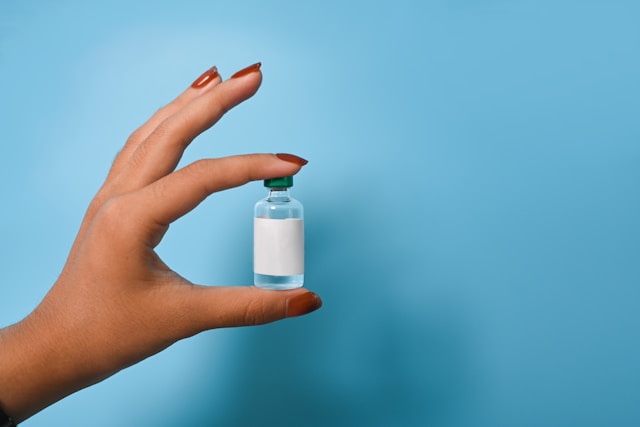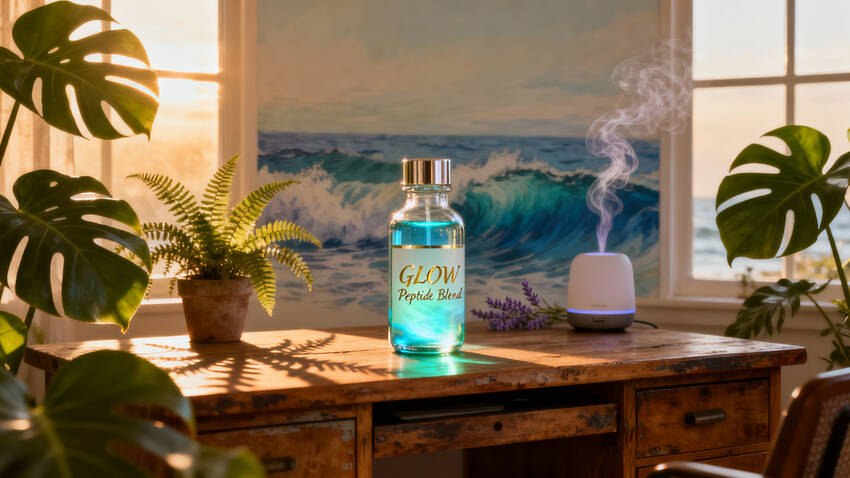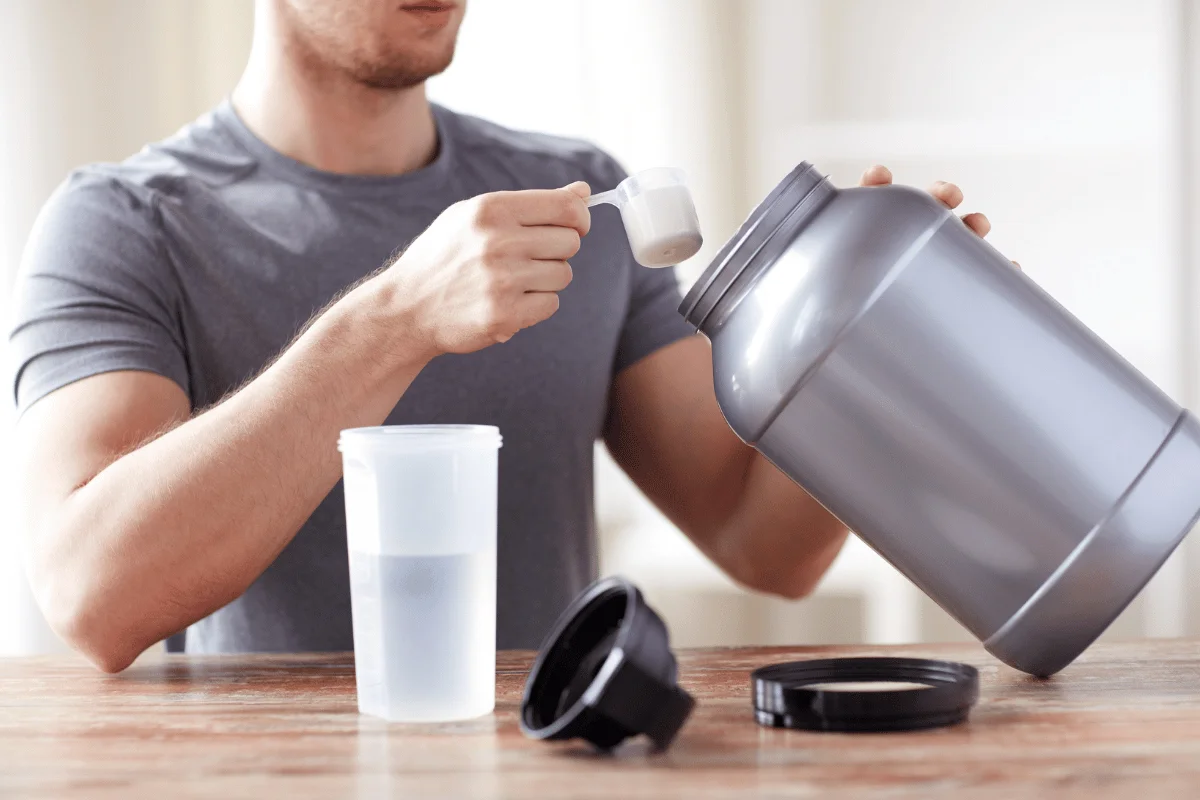[Disclaimer: This article is for informational purposes only and does not constitute medical advice. Always consult with a qualified healthcare provider before considering any peptide therapy.]
The GLOW peptide protocol combines three powerful therapeutic peptides into a single injection designed to target tissue repair, skin rejuvenation, and accelerated healing. This triple stack approach is becoming popular in regenerative medicine for its ability to address multiple health concerns at the cellular level.
The protocol gets its name from the visible skin improvements many users report within 2 to 3 weeks. The benefits extend far beyond cosmetic changes to include faster injury recovery, reduced inflammation, and better overall healing capacity.
Quick Takeaways
- The GLOW peptide protocol combines BPC-157, TB-500, and GHK-Cu into one injection for skin rejuvenation and tissue repair.
- Users often see visible improvements in skin texture and wound healing within 2 to 3 weeks of starting the protocol.
- Standard dosing involves daily subcutaneous injections of 900 to 1800 mcg for 6 weeks, followed by a 3 week break.
- While the three peptides work together for better results, they are not FDA-approved for human therapeutic use and require medical supervision.
What is the GLOW Peptide Protocol?
The GLOW peptide protocol is a regenerative medicine approach that delivers BPC-157, TB-500, and GHK-Cu through subcutaneous peptide injection. Each component targets different healing pathways, creating synergistic effects that individual peptides cannot achieve alone.
BPC-157 derives from human gastric juice and contains 15 amino acids that support body protection mechanisms. TB-500 is a synthetic fragment of thymosin beta-4, a naturally occurring protein found in virtually all human cells. GHK-Cu is a copper peptide that binds copper ions and declines with age.
The standard GLOW blend contains 5mg of BPC-157, 10mg of TB-500, and 27mg of GHK-Cu for a total of 42mg per vial. Many clinics offer this pre-mixed formulation to simplify administration and improve patient compliance with the protocol.
The Three Peptides in GLOW
The power of the GLOW protocol lies in how these three peptides work together to support cellular repair and regeneration.
BPC-157: Body Protection Compound
BPC-157 promotes angiogenesis, the formation of new blood vessels that deliver oxygen and nutrients to damaged tissue. Research shows it accelerates wound healing across tendons, muscles, ligaments, and the gastrointestinal tract(1).
The peptide works by enhancing fibroblast migration and boosting collagen production. These actions help repair soft tissue through multiple cellular pathways while exhibiting potent anti-inflammatory effects(1).
A recent safety study published in Alternative Therapies in Health and Medicine showed that intravenous infusion of up to 20mg of BPC-157 in healthy adults was well tolerated with no adverse effects(2). Yet human clinical trials remain limited, with most evidence coming from animal studies.
TB-500: Thymosin Beta-4 Fragment
TB-500 increases actin production to aid cell movement and structure. This peptide therapy component helps with wound remodeling while reducing fibrosis, the formation of excess fibrous connective tissue.
Phase 1 safety studies in healthy volunteers show thymosin beta-4 is well tolerated even at higher doses with no dose-limiting toxicities(3). A Phase 2 trial in severe dry eye patients demonstrated both safety and meaningful symptom improvement(4).
The peptide is metabolized in the liver with serial cleavage at the C-terminus. Metabolites remain detectable in urine for up to 4 days after administration.
GHK-Cu: The Copper Peptide
GHK-Cu is a tripeptide found in human plasma at levels averaging 200 ng/ml at age 20 but declining to 80 ng/ml by age 60. This age-related decline correlates with reduced healing capacity and visible signs of aging.
The copper peptide stimulates Types I and III collagen while promoting elastin synthesis. Studies show GHK-Cu can increase cell viability 12.5-fold and boost basic fibroblast growth factor production by 230%(5).
Research demonstrates that when combined with LED therapy, this peptide boosts collagen synthesis by 70%. The copper-binding properties also provide antioxidant protection and support nerve outgrowth for tissue regeneration(5).
Science-Backed Benefits of GLOW
The GLOW protocol targets multiple healing pathways through its combination of three peptides working at the cellular level.
Skin Rejuvenation and Anti-Aging Effects
The protocol addresses skin health through several mechanisms that improve both appearance and function.
Visible improvements include:
- Wrinkle reduction within 2 to 3 weeks of starting treatment
- Better skin texture and firmness through increased collagen and elastin
- More radiant skin tone and improved overall appearance
- Faster wound healing with less scarring
- Better skin elasticity from stimulated collagen production
Many users report a natural “glow” that gives the protocol its name. The anti-aging effects come from the peptides’ ability to stimulate collagen production and reduce inflammation at the cellular level.
Tissue Repair and Recovery
The GLOW peptide goes beyond cosmetic benefits to support whole-body healing and recovery.
Recovery benefits include:
- Accelerated healing for surgery, sports injuries, and chronic damage
- Better muscle recovery and reduced exercise-induced inflammation
- Improved joint flexibility with less stiffness
- Faster tendon and ligament repair through better blood vessel formation
- Gut healing support for intestinal permeability issues
Endurance athletes often use the protocol to shorten recovery time between training sessions and competitions. The tissue repair effects work through multiple pathways that accelerate natural healing processes.
Third-Party Tested, 99% Purity
Order lab-verified peptides from our top recommended vendor.

How to Use the GLOW Protocol
Proper GLOW peptide blend dosing and timing are key to getting the best results while minimizing potential side effects.
GLOW Peptide Injection Dosage Guidelines
Most practitioners recommend a dose of 900 to 1800 mcg daily, which equals 10 to 20 units when the 42mg blend is reconstituted with 3mL bacteriostatic water. Start at the lower end of this range and increase gradually based on your response.
For general health and skin rejuvenation, daily subcutaneous injection works best. Those focused on tissue repair and athletic recovery may use the protocol 3 to 5 times per week for 4 to 6 weeks.
| Goal | Frequency | Duration |
|---|---|---|
| Skin rejuvenation | Daily | 6 weeks on, 3 weeks off |
| Tissue repair | 3-5 times weekly | 4-6 weeks |
| Athletic performance | 3-5 times weekly | During training cycles |
If using the peptides separately rather than as a pre-mixed blend, typical individual dosing includes 200 to 500 mcg of BPC-157 daily, 4 to 6mg of TB-500 weekly, and 0.2mL of GHK-Cu daily.
Timing and Frequency
You can administer the peptide injection at any time of day. Some people prefer evening injections to minimize any mild side effects during sleep.
The most common cycling protocol is 6 weeks on, 3 weeks off. This approach prevents receptor desensitization and allows your body to reset natural peptide production. Some protocols suggest 2 months on, 1 month off for more intensive therapeutic applications.
Rotate injection sites between the abdomen, upper thigh, or back of the upper arm to prevent localized irritation. This site rotation helps reduce inflammation and keeps the injection site healthy throughout your protocol.
Safety and Side Effects
The GLOW protocol is generally well tolerated, but understanding potential reactions helps you use it safely.
Common Reactions
Most side effects occur at the injection site and resolve within a few days without intervention.
Injection site reactions may include:
- Mild redness and swelling around the injection area
- Tenderness or slight pain that fades quickly
- Itching or small bruising at the site
- Temporary warmth where you injected
Systemic effects can include:
- Mild water retention
- Temporary headaches
- Changes in appetite
- Mild fatigue
Dr. Jeffrey Peng, an orthopedist and sports medicine specialist, notes important limitations: “The reality is that there are currently ZERO randomized controlled trials studying BPC-157 in humans. The major concern is the lack of substantial evidence confirming safety in humans.”
Who Should Avoid GLOW?
Certain warning signs require immediate medical attention, including spreading redness, severe pain that worsens, systemic allergic reactions, or persistent fever.
Important safety factors include using pharmaceutical-grade peptides from reputable sources, following proper sterile injection techniques, and avoiding excessive dosing. Medical supervision is especially important for those with underlying health conditions or taking other medications.
Pregnant or nursing women should avoid the protocol, as should anyone with active cancer or a history of malignancy. The peptides’ effects on cell growth and proliferation require careful consideration in these populations.
GLOW vs. Individual Peptide Therapy
The combination approach offers distinct advantages over using each peptide separately.
The three peptides create synergistic effects that exceed individual benefits. BPC-157 and TB-500 work together to speed tissue repair, while GHK-Cu supports collagen production and reduces inflammation. This multi-targeted approach addresses healing from several angles at once.
A single injection is more convenient than administering multiple separate doses throughout the day. The pre-mixed formulation also tends to be more cost effective compared to purchasing BPC-157, TB-500, and GHK-Cu separately.
Some practitioners add KPV peptide to create a “KLOW” protocol with additional antiinflammatory benefits. This extended combination targets even more regenerative pathways for comprehensive healing support.
GLOW vs. Traditional Therapies
The GLOW protocol takes a different approach compared to conventional anti-aging and healing treatments.
Unlike Botox or dermal fillers that mask symptoms temporarily, GLOW works by stimulating natural healing processes at the cellular level. This leads to more natural results that may last longer because you’re supporting your body’s own repair mechanisms.
Traditional wound care focuses on external interventions like bandages and topical medications. The GLOW peptide protocol works from the inside out by promoting new blood vessels, accelerating collagen production, and reducing inflammation throughout the body.
For athletes, conventional recovery often relies on rest, ice, compression, and elevation. While these remain important, peptide therapy adds another dimension by accelerating cellular repair and reducing recovery time between training sessions.
The protocol also differs from standard anti-aging treatments by addressing multiple factors at once. Rather than targeting just wrinkles or just skin texture, it improves overall skin health through better collagen and elastin production, improved blood flow, and reduced inflammation.
Regulatory and Legal Considerations
Understanding the legal status of GLOW peptides helps you make informed decisions about this therapy.
The peptides in GLOW are not FDA-approved for human therapeutic use. They are typically sold for research purposes only, which creates important considerations around quality control and legal status.
Quality varies significantly between suppliers, with some offering pharmaceutical-grade compounds while others provide lower-quality products. Working with a licensed clinic or physician who sources from regulated compounding pharmacies helps ensure you receive tested, pure peptides.
Both BPC-157 and TB-500 are banned by the World Anti-Doping Agency (WADA) for competitive athletes. If you participate in tested sports, using these peptides could result in sanctions or disqualification.
Many clinics now offer GLOW as part of supervised peptide therapy programs. This clinical context provides medical oversight, proper dosing guidance, and monitoring for potential side effects. Working with experienced practitioners helps you get better results while reducing risks associated with self-administration.
Some jurisdictions have specific regulations around peptide sales and use. Check your local laws and regulations before starting any peptide protocol, and always work with qualified healthcare providers who understand both the science and legal landscape.
The Bottom Line
The GLOW peptide protocol offers a science-based approach to skin rejuvenation and tissue repair through the combined action of BPC-157, TB-500, and GHK-Cu. These three peptides work together to stimulate collagen production, accelerate wound healing, reduce inflammation, and improve radiant skin appearance.
While preliminary evidence looks promising, this therapy requires informed caution and medical supervision. Source your peptides from reputable clinics, start with conservative dosing, follow proper cycling protocols, and maintain realistic expectations about results. The protocol may represent an exciting option for those seeking to support their body’s natural healing processes, but always prioritize safety and work with qualified healthcare providers experienced in peptide therapy.
References
1. Vasireddi N, Hahamyan H, Salata MJ, Karns M, Calcei JG, Voos JE, et al. Emerging Use of BPC-157 in Orthopaedic Sports Medicine: A Systematic Review [Internet]. HSS Journal®: The Musculoskeletal Journal of Hospital for Special Surgery. SAGE Publications; 2025 Jul. Available from: https://doi.org/10.1177/15563316251355551
2. Lee E, Burgess K. Safety of Intravenous Infusion of BPC157 in Humans: A Pilot Study. Alternative Therapies in Health and Medicine. 2025;
3. Wang X, Liu L, Qi L, Lei C, Li P, Wang Y, et al. A first‐in‐human, randomized, double‐blind, single‐ and multiple‐dose, phase I study of recombinant human thymosin β4 in healthy Chinese volunteers [Internet]. Vol. 25, Journal of Cellular and Molecular Medicine. Wiley; 2021 Aug p. 8222–8228. Available from: https://doi.org/10.1111/jcmm.16693
4. Sosne G, Dunn SP, Kim C. Thymosin β4 Significantly Improves Signs and Symptoms of Severe Dry Eye in a Phase 2 Randomized Trial [Internet]. Vol. 34, Cornea. Ovid Technologies (Wolters Kluwer Health); 2015 May p. 491–496. Available from: https://doi.org/10.1097/ico.0000000000000379
5. Pickart L, Margolina A. Regenerative and Protective Actions of the GHK-Cu Peptide in the Light of the New Gene Data [Internet]. Vol. 19, International Journal of Molecular Sciences. MDPI AG; 2018 Jul p. 1987. Available from: https://doi.org/10.3390/ijms19071987








